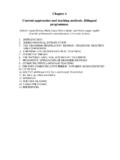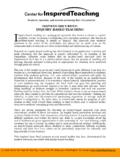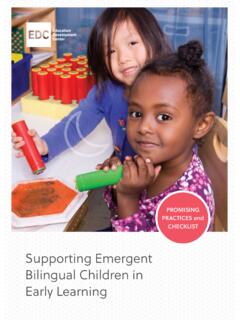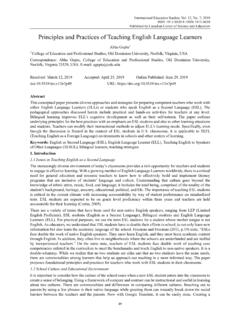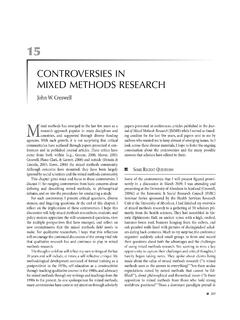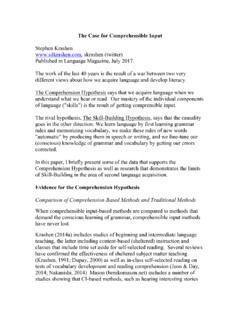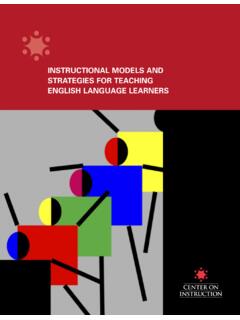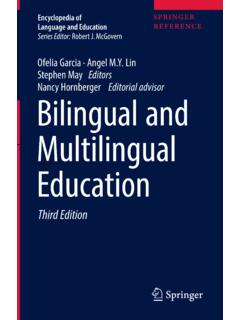Transcription of Bilingual Teaching Methods - Bangor University
1 Bilingual Teaching Methodsa quick reference guide for educatorsBased on world-wide research, this booklet provides a wealth of classroom possibilities, and teachers can chose what fits their own context and preferencesColin BakerEnlli M n ThomasDafydd ApolloniNia Mererid Parry IntroductionIt is hoped that this booklet will be a useful reference resource for teachers as they go about planning their lessons with a view to enriching and/or developing the Welsh language skills of children, be they ready Welsh-speakers or learners at different stages of the booklet is intended for use by teachers designing strategies for Teaching in Welsh-medium schools, in Bilingual schools, and for bringing pupils into contact with Welsh in English-medium schools in Wales..the effectiveness of any [ Bilingual Teaching ] method or approach is less influential than the skill and competence of the teacher delivering itFitzpatrick et al.
2 , 2018, The aim of this booklet is to provide a brief overview of the international literature relating to Teaching and pedagogical Methods in the context of Bilingual education and Bilingual classrooms, relating those practices to the education context here in strategies will take us a step closer towards fulfilling one particular aspect of the Welsh Government s vision, namely to secure a generation of teachers who are aware of the key steps required in realizing Cymraeg: 2050, and who are research-informed:2050 Content Bilingual learning/ Teaching of interaction correction: Targeting the appropriate use of Welsh strategies input - child output: ensuring opportunities to create extended Bob speaker Language Integrated Learning (CLIL) first languagesecond languageImportant termsThroughout this booklet your will see the following terms.
3 Please take a moment to familairse yourself with them. 2018 Enlli M n ThomasDafydd ApolloniNia Mererid ParryISBN: 978-1-84220-171-8 Main Bilingual Learning/ Teaching ModelsThere is a general tendency to divide Bilingual Teaching models into one of two types: the type that follows a monolingual approach, on the one hand, and the type that follows a Bilingual approach on the other. The first of these is based on the deliberate separation of the learner s two languages within the school and classroom context in general - a practice which (if we ignore the minor translations that occur in order to increase learners understanding) is still to be found in classrooms across Wales (Lewis et al., 2013) as well as in Canada (Byrd Clark, 2012) despite Wales having a progressive tradition in Bilingual education, it is the case that, especially at the secondary school classroom level, there tends to be some degree of language separation rather than a considered approach to translanguaging ( Jones, 2017, ).
4 In such situations, the language of Teaching is often different from that of the child s first language, and opportunities to take advantage of and use their full linguistic repertoire are rare. Such models are often implemented for the purpose of language preservation; in that regard, it could be argued that such strategies are essentially intended to encourage pupils development in the target language (such as in the immersion method), rather than representing a specific educational methodology per se ( Duibhir, 2018). Amongst the models that encourage language separation are what the formal academic literature refer to as the direct method, the audiolingual approach, and some aspects of CLIL models (Content and Language Integrated Learning) (Paradowski, 2017), along with some extreme versions of immersion Monolingual Models2.
5 Bilingual ModelsCurrently in Wales, as in many other countries of the world, there is an increasing awareness of the Bilingual speaker s unique linguistic profile (Grosjean, 1985) - the multi-competence that arises from learning and being able to communicate in more than one language (Cook, 1992). The notion that Bilingual speakers function as two monolinguals is incorrect, and drawing comparisons between, or to have the same expectations of second language speakers and native first language or monolingual speakers is inappropriate. By now, our recognition and understanding that Bilingual speakers have two languages that not only influence each other in different ways ( by transferring grammatical structures and vocabulary from one language to the other; by promoting, enriching and sometimes slowing down the development and understanding of forms in one language or the other - see Cook, 1992), but also have a more universal effect on the individual s cognitive system (see Thomas & Webb-Davies, 2017), forms a core part of the thinking that underpins effective language pedagogy.
6 The key and indeed defining feature that distinguishes the learning/acquisition of a foreign/second/third etc. tongue from first language the presence of at least one other linguistic system in the speaker s mind Paradowski, 2017, p. 3 The idea that the target language has to be isolated from other languages in the learners repertoire has old roots in the direct and audio-lingual methodsCenoz & Gorter, 2017, p. 310In that respect, learning a language is very similar to learning anything else: when coming across new information, the brain is able to relate that piece of information to existing information and expand knowledge accommodating and assimilating information as Piaget would put it. When learning a second language or developing two languages simultaneously, the Bilingual can benefit from his/her ability to compare and contrast - across their two languages - different words, phrases, sounds and structures, and discover differences in meanings attached to those forms.
7 This develops an awareness of the vast extent of languages - what languages are, how they work, how they are used and can be learnt (Paradowski, 2017, p. 141) referred to in the literature as metalinguistic skills - skills that influence strongly the child s later linguistic successes (Carlisle, Beeman, Davis & Spharim, 1999). There is, therefore, an increasing emphasis on the second type of Bilingual Teaching model, suggesting that practices have moved away from strict language separation and towards approaches and models that allow, promote and encourage a mix of languages in the classroom (Lewis et al., 2012), reflecting more accurately the learner s real-life experiences. This does not mean that there is no key role for Welsh-medium education! On the contrary, immersing children in Welsh is essential, and ensuring frequent opportunities to see, hear, process and use the language naturally is crucial if the language is to thrive.
8 In such contexts, Bilingual Teaching Methods serve to enrich pupils experience of being educated primarily through a minority language, with the ultimate goals of ensuring that learners become confident models that tend towards bilingualism vary, and include a wide range of practices that can be more, or less, formal, structured or spontaneous, derive from deliberate planning on the part of the teacher or depend on pupils chosen language, some of which will feature in this booklet will therefore focus on the second model type - pedagogical approaches and strategies that allow access to and awareness of the learner s linguistic experience and background, whilst helping them develop into confident Bilingual speakers. knowledge or a subject (the content ) through the medium of a language that is new to a child (the linguistic medium) is challenging, and the linguistic interaction between the teacher and the child is key, not only for the purpose of identifying the child s achievements linguistically and intellectually, but also in terms of encouraging the child s continued use of the of InteractionTeachers in immersion schools act as both content teachers and language teachers and they attempt to create naturalistic conditions similar to those in which L1 learning takes place Duibhir, 2018, p.
9 55 The informal context of the early years classrooms lends itself well to naturalistic speech and interaction amongst children. However, at this early age, many of the children lack sufficient conversational abilities in Welsh which means that for those who are lacking exposure to Welsh outside school, the only way to converse fully with another child (and also with the teacher) is in EnglishThomas, Lewis & Apolloni, 2012, p. 255 Lyster et al. ( , Lyster & Rannta, 1997; Lyster & Mori, 2006), found that recasts were the most frequent feedback used by teachers. Recasts were considered to be effective as it encourages the pupil to concentrate on form. However, this type of approach is likely to be more effective with older rather than younger children - children who have a relatively good grasp of at least one language system - and there is plenty of evidence that correcting the utterance of very young children, even by encouraging them to imitate the exact same sentences when corrected, is difficult (see example from McNeill, 1966).
10 If a child s utterance is ungrammatical in Welsh, if they use an incorrect word for a particular meaning, or if they over-use (or are over- or totally dependent on) another language, it is good practice to respond by discussing the correct meaning or the appropriate form by resorting to one of the following (Lyster & Rannta, 1997 - from Duihbir, 2018, p 43):Explicit correctionCorrecting the utteranceRecastsThe teacher recasts the utterance without repeating the error . Clarification requestsCommunicate to the child that the utterance is not comprehensible to the teacher or that the utterance is poorly formed and that it is necessary to re-present or reconstruct feedbackDiscuss by questioning, commenting or sharing information relating to the appropriateness of the utterance without presenting the target of another responseThis may involve asking the child directly to re-present the utterance; re-presenting part of the utterance to the child and encouraging him/her to complete the utterance; asking the child directly which form is most appropriate for the utterance, and drawing specific attention to the divergence from the target correction: Targeting appropriate use of WelshMcNeill, 1966 When to correct ?






